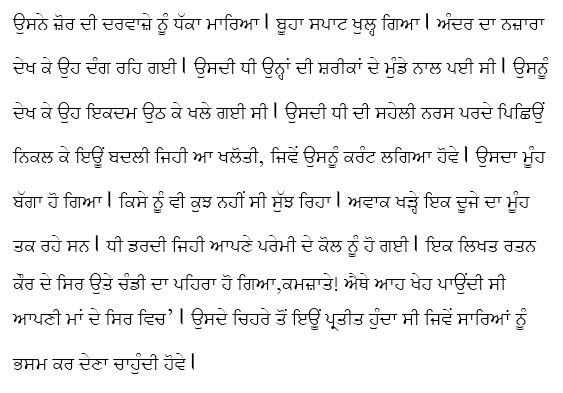

Ali's short story collection Kahani Praga received the Waris Shah Memorial Award in 2005 from the Pakistan Academy of Letters. The work of Zaman and Randhawa often treats the rediscovery of Punjabi identity and language in Pakistan since 1947. Literary criticism in Punjabi has also emerged through the efforts of West Punjabi scholars and poets, Shafqat Tanvir Mirza, Ahmad Salim, and Najm Hosain Syed (b. Najm Hossein Syed, Fakhar Zaman and Afzal Ahsan Randhawa are some of the more prominent names in West Punjabi literature produced in Pakistan since 1947. Post-Independence Western Punjab (Pakistan)

The Punjabi diaspora also began to emerge during the Raj and also produced poetry whose theme was revolt against British rule in Ghadar di Gunj ( Echoes of Mutiny). Mohan Singh (1905–78) and Shareef Kunjahi. Modernism was also introduced into Punjabi poetry by Prof. Brought up on English and American poetry, Puran Singh was also influenced by Freudian psychology in his oftentimes unabashedly sensuous poetry. Chatrik's poetry, steeped in Indian traditions of romance and classical poetry, often celebrated varied moods of nature in his verse as well as feelings of patriotism. Other poets meanwhile, such as Dhani Ram Chatrik (1876–1957), Diwan Singh (1897–1944) and Ustad Daman (1911–1984), explored and expressed nationalism in their poetry during and after the Indian freedom movement. Punjabi poetry during the British Raj moreover began to explore more the experiences of the common man and the poor through the work of Puran Singh (1881–1931). The novels, short stories and poetry of Amrita Pritam (1919–2005) highlighted, among other themes, the experience of women, and the Partition of India. Starting off as a pamphleteer and as part of the Singh Sabha Movement, Vir Singh wrote historical romance through such novels as Sundari, Satwant Kaur and Baba Naudh Singh, whereas Nanak Singh helped link the novel to the storytelling traditions of Qissa and oral tradition as well as to questions of social reform. The Punjabi novel developed through Nanak Singh (1897–1971) and Vir Singh. The first Punjabi printing press (using Gurmukhi font) was established through a Christian mission at Ludhiana in 1835, and the first Punjabi dictionary was published by Reverend J.
#PUNJABI SHAYARI IN GURMUKHI FONT FREE#
The Victorian novel, Elizabethan drama, free verse and Modernism entered Punjabi literature through the introduction of British education during the Raj. The Jangnama, or 'War Chronicle,' was introduced into Punjabi literature during the Mughal period the Punjabi Jangnama of Shah Mohammad (1780–1862) recounts the First Anglo-Sikh War of 1845–46. The semi-historical Nadir Shah Di Vaar by Najabat describes the invasion of India by Nadir Shah in 1739. Prominent examples of heroic or epic poetry include Guru Gobind Singh's in Chandi di Var (1666–1708). Heroic ballads known as Vaar enjoy a rich oral tradition in Punjabi. Other popular stories include Sohni Mahiwal by Fazal Shah, Mirza Sahiba by Hafiz Barkhudar (1658–1707), Sassi Punnun by Hashim Shah (1735?–1843?), and Qissa Puran Bhagat by Qadaryar (1802–1892). The Qissa of Heer Ranjha by Waris Shah (1706–1798) is among the most popular of Punjabi qisse. Punjabi Sufi poetry also influenced other Punjabi literary traditions particularly the Punjabi Qissa, a genre of romantic tragedy which also derived inspiration from Indic, Persian and Quranic sources. In contrast to Persian poets, who had preferred the ghazal for poetic expression, Punjabi Sufi poets tended to compose in the Kafi. Guru Nanak himself composed Punjabi verse incorporating vocabulary from Sanskrit, Arabic, Persian, and other South Asian languages as characteristic of the Gurbani tradition. The Janamsakhis, stories on the life and legend of Guru Nanak (1469–1539), are early examples of Punjabi prose literature. whose Sufi poetry was compiled after his death in the Adi Granth. The Punjabi literary tradition is popularly seen to commence with Fariduddin Ganjshakar (1173–1266). They referred to God with various names such as "Alakh Nirajan" which are still prevalent in Punjabi vernacular. Hindu Nath Yogis were the first poets to use Punjabi language in praise of God.


 0 kommentar(er)
0 kommentar(er)
